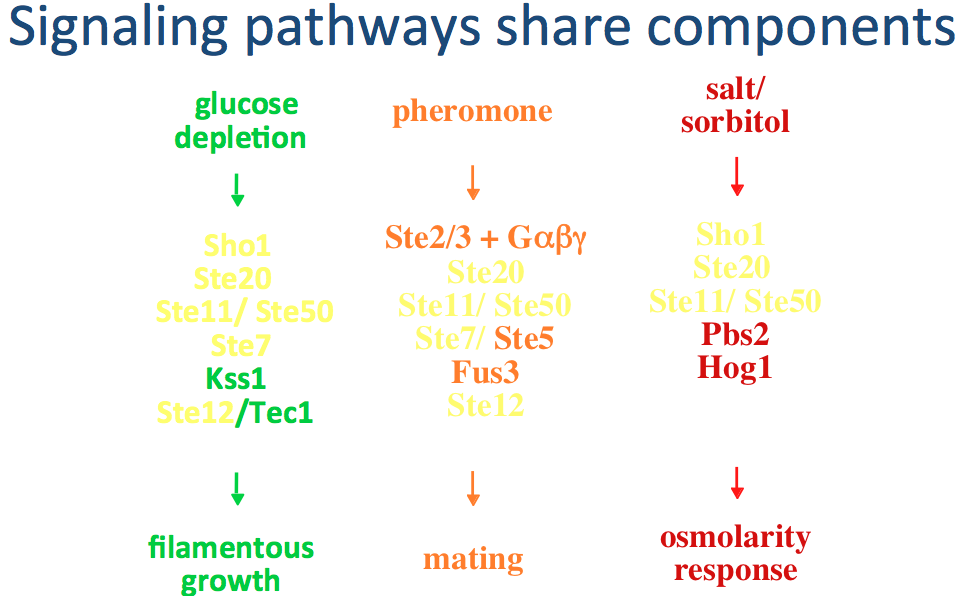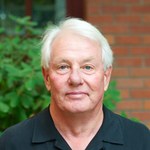Home | About | Faculty | Calendar | Facilities | Graduate program | Contact | Apply
This page is optimized for viewing with javascript.
George F. Sprague, Jr
Loading profile for George Sprague
Research Interests
George Sprague is no longer active in research but is still active in the Biology Department teaching program.
During his research career he used yeast as a model to investigate basic problems in genetics and cell biology. His primary interests were:- Transcriptional regulatory mechanisms that determine cell type
- Mechanisms by which signal transduction pathways are regulated and signaling specificity is maintained
- Mechanisms by which cell polarity decisions are executed
 Localization of Bud4p, a protein required for the axial budding pattern. Bud4p was fused to green fluorescence protein (GFP) and visualized by virtue of the intrinsic fluorescence of GFP. Although the budding pattern of yeast cells changes when they are shifted from glucose rich to glucose limiting conditions, the localization of Bud4p does not change.
Localization of Bud4p, a protein required for the axial budding pattern. Bud4p was fused to green fluorescence protein (GFP) and visualized by virtue of the intrinsic fluorescence of GFP. Although the budding pattern of yeast cells changes when they are shifted from glucose rich to glucose limiting conditions, the localization of Bud4p does not change.
 The three yeast cell types and the regulatory proteins encoded by the MAT locus are depicted. These proteins, together with Mcm1, which is encoded elsewhere in the genome, govern expression of three sets of genes: a-specific genes, α-specific genes, and a1·α2-repressed genes. Figure taken from: Sprague GF, PNAS 2005;102:959-960.
The three yeast cell types and the regulatory proteins encoded by the MAT locus are depicted. These proteins, together with Mcm1, which is encoded elsewhere in the genome, govern expression of three sets of genes: a-specific genes, α-specific genes, and a1·α2-repressed genes. Figure taken from: Sprague GF, PNAS 2005;102:959-960.
 Three MAPK pathways in yeast share common components and also contain pathway-specific factors.
Three MAPK pathways in yeast share common components and also contain pathway-specific factors.
Recent publications
(pulled from pubmed)
Recent publications
(pulled from pubmed)
The regulation of filamentous growth in yeast.
Cullen PJ, Sprague GF Jr
Genetics 2012 Jan;190(1):23-49
Cullen PJ, Sprague GF Jr
Genetics 2012 Jan;190(1):23-49
Eukaryotes learn how to count: quorum sensing by yeast.
Sprague GF Jr, Winans SC
Genes Dev 2006 May 1;20(9):1045-9
Sprague GF Jr, Winans SC
Genes Dev 2006 May 1;20(9):1045-9
Three-pronged genomic analysis reveals yeast cell-type regulation circuitry.
Sprague GF Jr
Proc Natl Acad Sci U S A 2005 Jan 25;102(4):959-60
Sprague GF Jr
Proc Natl Acad Sci U S A 2005 Jan 25;102(4):959-60
The identification of Pcl1-interacting proteins that genetically interact with Cla4 may indicate a link between G1 progression and mitotic exit.
Keniry ME, Kemp HA, Rivers DM, Sprague GF Jr
Genetics 2004 Mar;166(3):1177-86
Keniry ME, Kemp HA, Rivers DM, Sprague GF Jr
Genetics 2004 Mar;166(3):1177-86
Yeast signal transduction: regulation and interface with cell biology.
Sprague GF, Cullen PJ, Goehring AS
Adv Exp Med Biol 2004;547:91-105
Sprague GF, Cullen PJ, Goehring AS
Adv Exp Med Biol 2004;547:91-105
A signaling mucin at the head of the Cdc42- and MAPK-dependent filamentous growth pathway in yeast.
Cullen PJ, Sabbagh W Jr, Graham E, Irick MM, van Olden EK, Neal C, Delrow J, Bardwell L, Sprague GF Jr
Genes Dev 2004 Jul 15;18(14):1695-708
Cullen PJ, Sabbagh W Jr, Graham E, Irick MM, van Olden EK, Neal C, Delrow J, Bardwell L, Sprague GF Jr
Genes Dev 2004 Jul 15;18(14):1695-708
Identification of p21-activated kinase specificity determinants in budding yeast: a single amino acid substitution imparts Ste20 specificity to Cla4.
Keniry ME, Sprague GF Jr
Mol Cell Biol 2003 Mar;23(5):1569-80
Keniry ME, Sprague GF Jr
Mol Cell Biol 2003 Mar;23(5):1569-80
Far3 and five interacting proteins prevent premature recovery from pheromone arrest in the budding yeast Saccharomyces cerevisiae.
Kemp HA, Sprague GF Jr
Mol Cell Biol 2003 Mar;23(5):1750-63
Kemp HA, Sprague GF Jr
Mol Cell Biol 2003 Mar;23(5):1750-63
Synthetic lethal analysis implicates Ste20p, a p21-activated potein kinase, in polarisome activation.
Goehring AS, Mitchell DA, Tong AH, Keniry ME, Boone C, Sprague GF Jr
Mol Biol Cell 2003 Apr;14(4):1501-16
Goehring AS, Mitchell DA, Tong AH, Keniry ME, Boone C, Sprague GF Jr
Mol Biol Cell 2003 Apr;14(4):1501-16
Autocrine activation of the pheromone response pathway in matalpha2- cells is attenuated by SST2- and ASG7-dependent mechanisms.
Rivers DM, Sprague GF Jr
Mol Genet Genomics 2003 Nov;270(3):225-33
Rivers DM, Sprague GF Jr
Mol Genet Genomics 2003 Nov;270(3):225-33
Urmylation: a ubiquitin-like pathway that functions during invasive growth and budding in yeast.
Goehring AS, Rivers DM, Sprague GF Jr
Mol Biol Cell 2003 Nov;14(11):4329-41
Goehring AS, Rivers DM, Sprague GF Jr
Mol Biol Cell 2003 Nov;14(11):4329-41
Attachment of the ubiquitin-related protein Urm1p to the antioxidant protein Ahp1p.
Goehring AS, Rivers DM, Sprague GF Jr
Eukaryot Cell 2003 Oct;2(5):930-6
Goehring AS, Rivers DM, Sprague GF Jr
Eukaryot Cell 2003 Oct;2(5):930-6
The roles of bud-site-selection proteins during haploid invasive growth in yeast.
Cullen PJ, Sprague GF Jr
Mol Biol Cell 2002 Sep;13(9):2990-3004
Cullen PJ, Sprague GF Jr
Mol Biol Cell 2002 Sep;13(9):2990-3004
GTPase-activating proteins for Cdc42.
Smith GR, Givan SA, Cullen P, Sprague GF Jr
Eukaryot Cell 2002 Jun;1(3):469-80
Smith GR, Givan SA, Cullen P, Sprague GF Jr
Eukaryot Cell 2002 Jun;1(3):469-80
The Glc7p-interacting protein Bud14p attenuates polarized growth, pheromone response, and filamentous growth in Saccharomyces cerevisiae.
Cullen PJ, Sprague GF Jr
Eukaryot Cell 2002 Dec;1(6):884-94
Cullen PJ, Sprague GF Jr
Eukaryot Cell 2002 Dec;1(6):884-94
The phosphotyrosyl phosphatase activator, Ncs1p (Rrd1p), functions with Cla4p to regulate the G(2)/M transition in Saccharomyces cerevisiae.
Mitchell DA, Sprague GF Jr
Mol Cell Biol 2001 Jan;21(2):488-500
Mitchell DA, Sprague GF Jr
Mol Cell Biol 2001 Jan;21(2):488-500
Defects in protein glycosylation cause SHO1-dependent activation of a STE12 signaling pathway in yeast.
Cullen PJ, Schultz J, Horecka J, Stevenson BJ, Jigami Y, Sprague GF Jr
Genetics 2000 Jul;155(3):1005-18
Cullen PJ, Schultz J, Horecka J, Stevenson BJ, Jigami Y, Sprague GF Jr
Genetics 2000 Jul;155(3):1005-18
Glucose depletion causes haploid invasive growth in yeast.
Cullen PJ, Sprague GF Jr
Proc Natl Acad Sci U S A 2000 Dec 5;97(25):13619-24
Cullen PJ, Sprague GF Jr
Proc Natl Acad Sci U S A 2000 Dec 5;97(25):13619-24
Control of MAP kinase signaling specificity or how not to go HOG wild.
Sprague GF Jr
Genes Dev 1998 Sep 15;12(18):2817-20
Sprague GF Jr
Genes Dev 1998 Sep 15;12(18):2817-20
The ankyrin repeat-containing protein Akr1p is required for the endocytosis of yeast pheromone receptors.
Givan SA, Sprague GF Jr
Mol Biol Cell 1997 Jul;8(7):1317-27
Givan SA, Sprague GF Jr
Mol Biol Cell 1997 Jul;8(7):1317-27
Identification and characterization of FAR3, a gene required for pheromone-mediated G1 arrest in Saccharomyces cerevisiae.
Horecka J, Sprague GF Jr
Genetics 1996 Nov;144(3):905-21
Horecka J, Sprague GF Jr
Genetics 1996 Nov;144(3):905-21
Signal transduction and growth control in yeast.
Schultz J, Ferguson B, Sprague GF Jr
Curr Opin Genet Dev 1995 Feb;5(1):31-7
Schultz J, Ferguson B, Sprague GF Jr
Curr Opin Genet Dev 1995 Feb;5(1):31-7
Cloning and characterization of the Saccharomyces cerevisiae LYS7 gene: evidence for function outside of lysine biosynthesis.
Horecka J, Kinsey PT, Sprague GF Jr
Gene 1995 Aug 30;162(1):87-92
Horecka J, Kinsey PT, Sprague GF Jr
Gene 1995 Aug 30;162(1):87-92
Mutation of RGA1, which encodes a putative GTPase-activating protein for the polarity-establishment protein Cdc42p, activates the pheromone-response pathway in the yeast Saccharomyces cerevisiae.
Stevenson BJ, Ferguson B, De Virgilio C, Bi E, Pringle JR, Ammerer G, Sprague GF Jr
Genes Dev 1995 Dec 1;9(23):2949-63
Stevenson BJ, Ferguson B, De Virgilio C, Bi E, Pringle JR, Ammerer G, Sprague GF Jr
Genes Dev 1995 Dec 1;9(23):2949-63
The yeast pheromone response pathway: new insights into signal transmission.
Ferguson B, Horecka J, Printen J, Schultz J, Stevenson BJ, Sprague GF Jr
Cell Mol Biol Res 1994;40(3):223-8
Ferguson B, Horecka J, Printen J, Schultz J, Stevenson BJ, Sprague GF Jr
Cell Mol Biol Res 1994;40(3):223-8
MCM1 point mutants deficient in expression of alpha-specific genes: residues important for interaction with alpha 1.
Bruhn L, Sprague GF Jr
Mol Cell Biol 1994 Apr;14(4):2534-44
Bruhn L, Sprague GF Jr
Mol Cell Biol 1994 Apr;14(4):2534-44
Genetic mapping of STE20 to the left arm of chromosome VIII.
Horecka J, Sprague GF Jr
Yeast 1994 May;10(5):693-5
Horecka J, Sprague GF Jr
Yeast 1994 May;10(5):693-5
Protein-protein interactions in the yeast pheromone response pathway: Ste5p interacts with all members of the MAP kinase cascade.
Printen JA, Sprague GF Jr
Genetics 1994 Nov;138(3):609-19
Printen JA, Sprague GF Jr
Genetics 1994 Nov;138(3):609-19
Mutations that alter the third cytoplasmic loop of the a-factor receptor lead to a constitutive and hypersensitive phenotype.
Boone C, Davis NG, Sprague GF Jr
Proc Natl Acad Sci U S A 1993 Nov 1;90(21):9921-5
Boone C, Davis NG, Sprague GF Jr
Proc Natl Acad Sci U S A 1993 Nov 1;90(21):9921-5
Transcription of alpha-specific genes in Saccharomyces cerevisiae: DNA sequence requirements for activity of the coregulator alpha 1.
Hagen DC, Bruhn L, Westby CA, Sprague GF Jr
Mol Cell Biol 1993 Nov;13(11):6866-75
Hagen DC, Bruhn L, Westby CA, Sprague GF Jr
Mol Cell Biol 1993 Nov;13(11):6866-75
